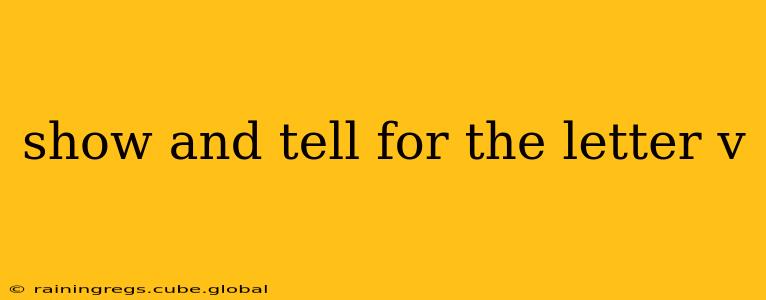The letter V, a dynamic and versatile character in the alphabet, holds a unique place in language and visual representation. This guide will explore the letter V through various engaging activities perfect for show and tell presentations, educational settings, or simply sparking curiosity in the letter's significance.
What Sounds Does the Letter V Make?
This is a fundamental question for understanding the letter V. The letter V typically produces a voiced labiodental fricative sound—a sound made by bringing the bottom lip to the upper teeth. Think of the sound in words like "van," "vine," and "very." However, it's important to note that pronunciation can vary slightly depending on the language and dialect.
What Words Start with the Letter V?
This is a great starting point for a show and tell. Bring along visual aids!
- Visuals: Create a poster or flashcards featuring words that begin with V. Consider categorizing them—vehicles (van, vehicle, Vespa), vegetables (vine, vegetable, vanilla), or verbs (visit, vibrate, vary). Pictures alongside the words make it more engaging.
- Examples: Van, victory, violet, volcano, vampire, vase, vacation, valley. Consider showing pictures or objects related to these words to enhance your presentation.
What Words Have the Letter V in the Middle?
Moving beyond initial sounds, we can highlight V's presence within words.
- Examples: Clever, over, seven, even, driver, lover. Again, visuals help reinforce understanding. Consider using word puzzles or games to help illustrate this.
- Activity: A fun activity would be creating a sentence using as many words containing the letter V as possible.
What Objects Begin with V?
This section ties the abstract concept of the letter to the tangible world.
- Show and Tell Ideas: Bring actual objects starting with V to your presentation. A vase, a small vehicle toy, or even a picture of a volcano are all excellent choices.
- Creative Extension: If possible, bring an object whose name contains the letter V, not just starts with it. For example, a video game controller or a velvet cushion. This helps show that V can appear anywhere in a word.
Can You Show Me Different Fonts That Use the Letter V?
This delves into the visual aspect of the letter, exploring its variations in different fonts.
- Examples: Print out examples of the letter V in various typefaces—serif fonts (like Times New Roman), sans-serif (like Arial), and script fonts. This highlights how the same letter can look vastly different depending on the font used.
- Discussion: Discuss how the design affects readability and overall aesthetic appeal.
How is the Letter V Used in Other Languages?
The universality (or variation) of the letter V across languages adds another layer of interest.
- Examples: The letter V exists in many alphabets, but its sound and usage might differ slightly. Research examples in Spanish, French, German, or other languages to illustrate these variations. Show how the same letter can represent different sounds or have different spellings.
Why is V Important in the Alphabet?
This provides a broader context for the letter’s role.
This final section reflects on the letter's role in the wider scheme of language and communication. Its existence facilitates the formation of numerous words, contributing to a richer and more nuanced vocabulary.
By following this comprehensive guide, you can create a vibrant and engaging show and tell presentation that captivates the audience and fosters a deeper understanding of the often-overlooked letter V. Remember to always emphasize the visual aspect, making the presentation as lively and dynamic as the letter itself!
